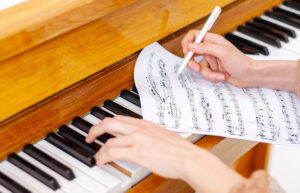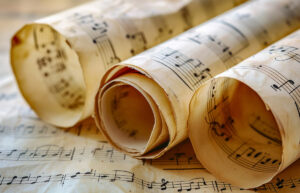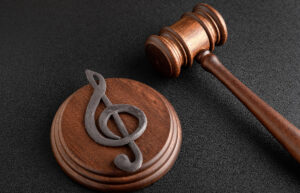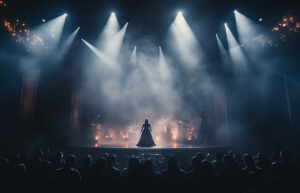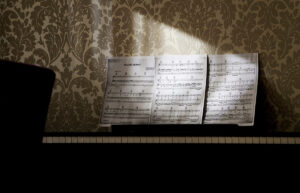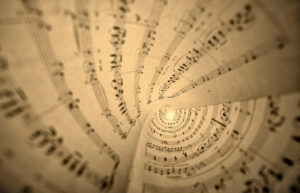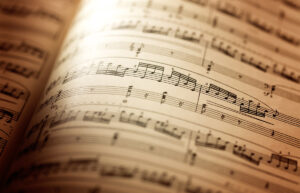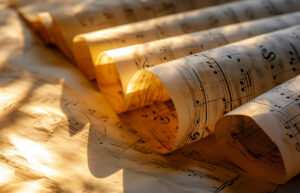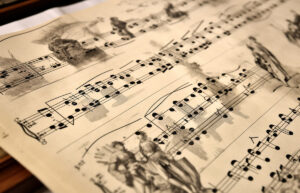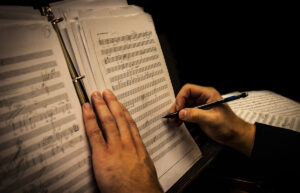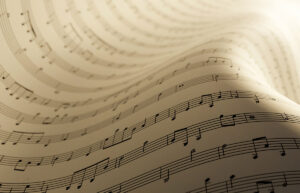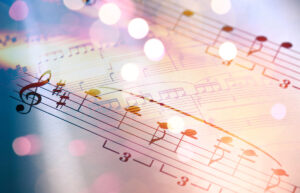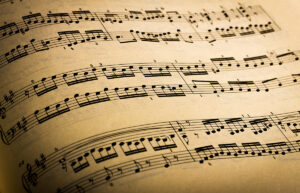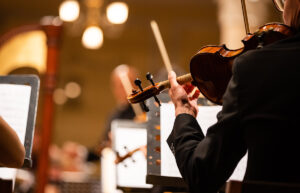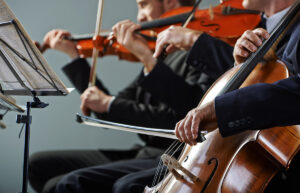What is Meter in Music: Meaning, Significance, Elements, Types & Examples

Have you ever found yourself tapping your foot to a song, sensing an invisible force guiding your every move? Enter the enchanting world of musical meters! Imagine swaying to a familiar tune, each step and nod perfectly synchronized with the rhythmic structure of the music. In this article, we embark on a rhythmic journey, delving into what is meter in music, and unraveling how it shapes our listening experience. So, tune in and prepare to uncover the intricate threads that weave through the melodies we cherish.
Welcome to TheDemoStop, now join the community!
Connect with artists, fans and producers around the world.
What is meter in music?
Meter refers to the organization of beats into recurring patterns, providing a rhythmic framework within a piece. It’s like the musical heartbeat or pulse that divides music into regular units of time. Understanding what is meter in music is crucial; it is commonly represented by a time signature at the beginning of a musical piece, indicating the number of beats per measure and the type of note that gets one beat.
For example, a 4/4 time signature means there are four beats per measure, and the quarter note receives one beat. The meter helps establish the groove, feel, and overall rhythmic structure of a composition, guiding performers and listeners alike through the rhythmic landscape of the music.
History of meter in music
The concept of what is meter in music has a rich history spanning centuries, shaped by cultural and musical developments. Ancient Greek theorists provided early insights, but the Middle Ages lacked standardized meter. The Renaissance brought about more precise rhythmic notation, setting the stage for the Baroque and Classical periods, which embraced standardized time signatures.
In the Romantic era, rhythmic freedom flourished, while the 20th century witnessed experimentation across genres with irregular rhythms. Throughout history, meter’s evolution reflects broader cultural shifts, from simplicity to complexity, shaping the rhythmic tapestry of music.
Significance of meter in music
Maintains fluidity
The meter acts as a rhythmic anchor, providing a consistent pulse that aids in the smooth flow of music. It creates a sense of continuity, allowing performers to synchronize their playing and enabling listeners to anticipate rhythmic patterns. This fluidity helps maintain the coherence and structure of a musical piece, guiding its progression without disruptions.
Sets the tone
The choice of meter greatly influences the mood and character of a musical composition. For instance, a piece in a lively 6/8 time signature might evoke a sense of dance and movement, while a slow 3/4 time signature could create a more introspective or melancholic atmosphere. Meter contributes significantly to the emotional and stylistic context of the music, setting the tone for the listener’s experience.
Identifies poets and trends
In the realm of lyric-based music, such as songs or poetry set to music, meter plays a crucial role. Different meters can align with various poetic structures or cultural traditions. Specific meters have been associated with certain periods, ports, or cultural trends, allowing listeners to identify the origins or influences of a piece based on its rhythmic structure.
Adds versatility and flair
The meter offers a canvas for creativity, allowing composers and performers to experiment with rhythmic variations and accents. By incorporating syncopation, changing time signatures, or utilizing irregular meters, musicians can add depth, complexity, and distinctive character to their compositions. This versatility contributes to the richness and diversity of musical styles across genres.
Elements of meter in music
Strong, mild, and weak beats
The meter organizes beats within a musical passage into distinct levels of emphasis. Typically, a meter consists of strong beats (often the first beat of a measure), followed by weaker beats (mild accents) and potentially even weaker or unaccented beats.
Rhythmic pattern
What is meter in music is defined by the recurring rhythmic pattern that governs a piece of music. It’s the regular arrangement of strong and weak beats within a measure, creating a rhythmic framework. For example, in 4/4 time, four beats per measure are often arranged as strong-weak-mild-weak or any variation that upholds the specified meter.
Tempo in BPM
Tempo refers to the speed or pace at which music is performed. While not explicitly defined by meter, the meter’s rhythmic structure can influence the perception of tempo. The BPM (Beats Per Minute) indicates the number of beats within a minute, providing a quantifiable measure of the speed at which the music progresses.
Syncopation and time signature
Syncopation occurs when accents fall on weak beats or off-beats, deviating from the expected strong beats within the meter. It adds a sense of unexpectedness or tension to the rhythm, creating interest and complexity. The time signature, represented at the beginning of a piece of music, indicates the meter’s structure and the number of beats per measure. For instance, 3/4 time signature denotes three beats per measure, with the quarter note receiving one beat.
Types of meter in music
Simple meter
Simple meter refers to time signatures where each beat is subdivided into two equal parts. The most common examples include 2/4 (two beats per measure, quarter note receives one beat) and 4/4 (four beats per measure, quarter note receives one beat). In a simple meter, each beat is divided into two equal parts, creating a straightforward rhythmic feel.
Duple meter
The duple meter features a grouping of two beats per measure. It divides each measure into two main beats, typically felt as strong-weak or down-up pulses. Examples include 2/4 and 2/2 time signatures, where two beats are the primary emphasis within each measure.
Triple meter
Triple meter involves a grouping of three beats per measure. It divides each measure into three main beats, often felt as strong-weak-mild or down-up-up pulses. Time signatures like 3/4 and 3/8 fall under a triple meter, emphasizing the three-beat division in each measure.
Welcome to TheDemoStop, now join the community!
Connect with artists, fans and producers around the world.
Compound meter
Compound meter differs from simple meter in that each beat subdivides into three equal parts. It involves the grouping of beats in multiples of three equal parts. It involves the grouping of beats in multiples of three. Examples include 6/8 (six beats per measure, eighth note receives one beat) or 9/8 time signatures. In compound meter, the beats are divided into three, creating a sense of a “big” beat subdivided into smaller parts.
Quadruple meter
Quadruple meter features a grouping of four beats per measure. It divided each measure into four main beats, often felt as stong-weak-mild-weak or down-up-mid-up pulses. Time signatures such as 4/4 and 4/2 fall under quadruple meter, where four beats are the primary emphasis within each measure.
How to recognize a meter in music?
Understanding how to recognize what is meter in music involves attentive listening and a focus on rhythmic patterns. Start by feeling the steady beat, perhaps by tapping your foot or nodding along with the music. Notice any accents or emphasized beats within each measure, paying attention to their strength.
Count the beats within a measure and observe how they’re grouped, whether in twos (simple meter), threes (triple meter), or other subdivisions. Look for the time signature provided at the beginning of the piece, indicating the number of beats per measure and the note value receiving one beat.
Consistency in the rhythmic pattern across the music helps confirm the identified meter. With practice and exposure to various musical styles, actively listening for these elements will enhance your ability to recognize and appreciate the meter in music.
Examples of meters in music
Duple Meter – 2 beats per measure – i.e. Sousa’s “Stars and Stripes”
This famous march by John Philip Sousa is a classical representation of the duple meter. The music carries a strong, steady pulse with two beats per measure. The recurring emphasis on every second beat gives it a distinct march-like quality, with a clear and consistent duple feel throughout the piece. The iconic melody and rhythm showcase the robust and spirited nature typical of duple meter compositions.
Triple Meter – 3 beats per measure – i.e. Strauss’ “Blue Danube Waltz”
Johann Strauss II’s “Blue Danube Waltz” epitomizes the triple meter with its graceful and flowing three-beat-per-measure structure. The waltz’s elegant and sweeping melodies, accompanied by the signature 1-2-3 rhythm, capture the essence of the triple meter. Its rhythmic foundation, characterized by a strong accent on the first beat, followed by two softer beats, creates the enchanting and dance-like quality associated with triple meter waltzes.
Quadruple Meter – 4 beats per measure – i.e. Queen’ “Love of My Life”
Queen’s ballad “Love of My Life” exemplifies the quadruple meter with its heartfelt and emotive four-beat-per-measure structure. The song maintains a steady, measured pace throughout, emphasizing a recurring pattern of four beats per measure. The clear division into four beats lends a sense of stability and structure to the music, allowing the emotional depth of the lyrics and melody to resonate within the rhythmic framework.
Conclusion
What is meter in music?
Meter in music organizes beats into recurring patterns within a piece, establishing a rhythmic framework shown by a time signature. It dictates the number of beats per measure and their emphasis, providing a steady pulse for musicians and listeners to navigate the composition’s rhythmic structure, influencing its feel and coherence.
History of meter in music
The history of meter in music traces back through various periods, starting with ancient civilizations establishing rudimentary rhythmic patterns. Ancient Greek theorists formalized rhythmic modes, evolving further in the Middle Ages with non-metered compositions. The Renaissance introduced more complex rhythmic notation, leading to the Baroque and Classical periods’ standardized use of time signatures.
Significance of meter in music
- Maintains fluidity
- Sets a tone
- Identifies poets and trends
- Adds versatility and flair
Elements of meter in music
- Strong, mild, and weak beats
- Rhythmic pattern
- Tempo in BPM
- Syncopation and time signature
Types of meter in music
- Simple meter
- Duple meter
- Triple meter
- Compound meter
- Quadruple meter
How to recognize a meter in music?
To recognize a meter in music, listen for the steady beat or pulse, notice accents or emphasized beats within each measure, count the beats to determine their grouping, check the time signature at the beginning of the piece, and observe the consistency in the rhythmic pattern. Active listening and attention to these elements help understand different meters in music.
Example of meters in music
- Duple Meter – 2 beats per measure – i.e. Sousa’s “Stars and Stripes”
- Triple Meter – 3 beats per measure – i.e. Strauss’s “Blue Danube Waltz”
- Quadruple Meter – 4 beats per measure – i.e. Queen’s “Love of My Life”
FAQs
What is meter in music?
Meter in music is the organization of beats into recurring patterns. It is essential for establishing the rhythmic structure of a composition and guiding both performers and listeners through its musical phrases.
What is the history of meter in music?
The history of meter in music traces back through ancient civilizations, progressing from Greek rhythmic modes and medieval non-metered compositions to Renaissance notation developments and the establishment of standardized time signatures in the Baroque and Classical periods. This evolution continues through the Romantic era’s embrace of rhythmic freedom to the 20th-century exploration of experimental rhythms, demonstrating its varied development across musical epochs.
What is the significance of meter in music?
- Maintains fluidity
- Sets a tone
- Identifies poets and trends
- Adds versatility and flair
How is meter determined in music?
To determine a meter in music, it’s important to listen for a consistent beat or pulse, observe any accents or emphasized beats within each measure, count the beats to discern their grouping, refer to the time signature provided at the outset of the piece, and note the consistency of the rhythmic pattern. Engaging in active listening and focusing on these aspects aids in comprehending various meters in music.
What are the different types of meters in music?
- Simple meter
- Duple meter
- Triple meter
- Compound meter
- Quadruple meter
What is a Simple meter?
A simple meter divides beats into two equal parts, as seen in time signatures like 2/4 or 4/4, providing a clear and straightforward rhythmic structure for music.
What is a Compound meter?
Compound meters, such as 6/8 or 9/8 time signatures, divide beats into three equal parts, creating a more complex rhythmic feel compared to simple meters.
What is a Complex meter?
Complex meters encompass irregular time signatures that don’t fit into standard categories, often featuring asymmetrical or changing beat groupings, challenging the traditional rhythmic expectations of listeners.
What is a Quadruple meter?
Quadruple meter, represented by time signatures like 4/4 or 4/2, consists of four beats per measure, offering a balanced yet versatile rhythmic foundation commonly found in various musical genres.
What are the elements of meter in music?
Elements of meter in music include strong, mild, and weak beats, rhythmic patterns, tempo in BPM, and syncopation, all of which contribute to the overall rhythmic structure and feel of a musical piece.
Who needs to know about meters in music?
Understanding meters in music is crucial for musicians, composers, conductors, and enthusiasts, as it enables them to interpret, perform, compose, and appreciate musical compositions with greater depth and understanding.






